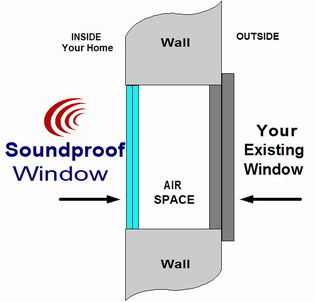How Soundproof Windows Work to Reduce Noise
Soundproof Windows do not Remove or Replace Your Existing Windows
Soundproof Windows rehabilitate your existing windows!!! There is no need for window replacement.
Windows and Doors are the Noise Problem
The windows are the major noise problem in over 90% of the cases. As an analogy: You turn on a radio very low. Now take another radio and turn it up full blast. Which radio do you hear? Well, the noisy one is your windows and the quiet one is the walls. Only until you turn down your window’s volume, will it be possible to hear the walls.
The noise problems are seldom the walls, but are always the windows. Only in extreme noise environments or very poor construction situations do the walls require any special noise abatement treatments.
Besides reducing noise, our soundproof windows can solve other window problems.
Our soundproof windows are second windows placed behind your existing windows. Our windows insulate, stop drafts, soundproof and more. They open and close just like your existing windows, and offer more benefits than replacement windows – at a significantly lower cost.
No construction mess or down time to install our soundproof windows.
No hassle installation takes only hours per room to install our soundproof windows. Simple, straightforward and fast. Also, a very clean installation with little, if any, mess.
Many custom colors.
Our soundproof windows allow you to change the inside appearance of your windows without changing the outside appearance. Available in many custom colors (at an additional cost), our soundproof windows soften the often harsh brown-bronze color or appearance of your current windows.
